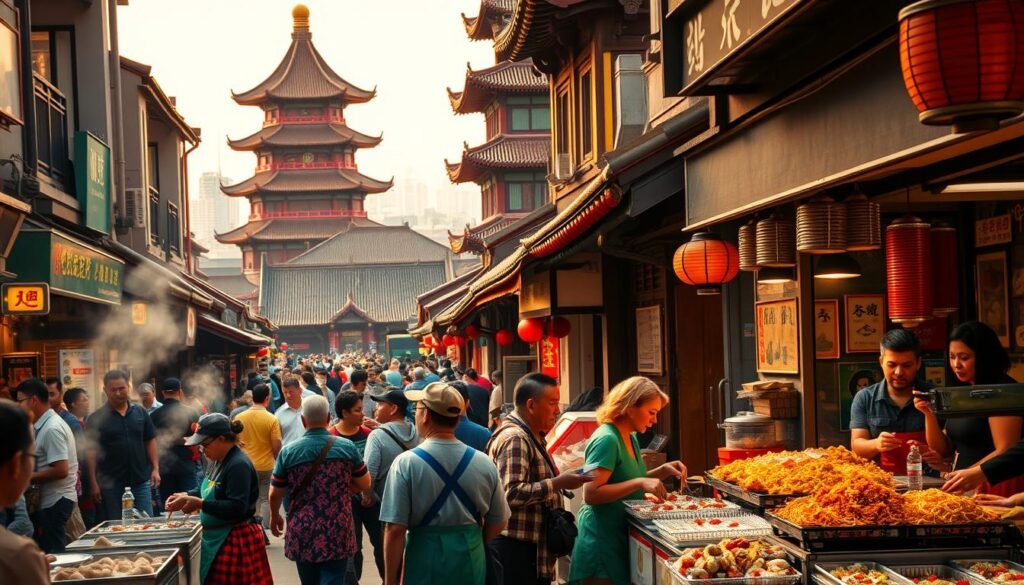
Beijing is a city filled with history and culture. It offers a unique culinary journey. The city has a wide range of delicious dishes that will excite your taste buds.
Beijing’s food scene is diverse, with dishes like roast duck and savory noodles. The city’s landmarks, like the Great Wall and Forbidden City, are also breathtaking. They draw visitors from all over the world.
Exploring Beijing, you’ll find a mix of flavors and historical sites. This makes Beijing a special place to visit.
Key Takeaways
- Discover Beijing’s rich culinary heritage
- Explore iconic landmarks like the Great Wall
- Experience the city’s cultural diversity
- Enjoy traditional dishes like roast duck
- Visit historical sites like the Forbidden City
The Cultural Heritage of Beijing Through Food and Architecture
Beijing is a living museum, showing a mix of old traditions and new ideas. It has a history of over 3,000 years. This history is seen in its food and buildings.
How 3,000 Years of History Shaped Beijing’s Culinary Traditions
Beijing’s food has been shaped by its past as a center of culture and politics. Traditional Chinese cuisine in Beijing has grown over time. It combines flavors and cooking styles from different places.
| Cuisine Aspect | Influence | Example |
|---|---|---|
| Imperial Cuisine | Royal Preferences | Peking Duck |
| Regional Flavors | Local Ingredients | Jianbing |
The Blend of Imperial and Modern Influences on Beijing’s Cityscape
Beijing’s buildings show both historic landmarks and new designs. The Forbidden City, a symbol of the past, is next to modern structures. This shows how the city has changed.
This mix of old and new makes Beijing special. It’s a place that draws visitors from all over.
Peking Duck: Beijing’s Legendary Culinary Masterpiece
Peking Duck has a long history, dating back to the imperial era. It’s a must-try dish in Beijing. Known for its crispy skin and tender meat, it’s served with pancakes, scallions, and sweet bean sauce.
The Imperial Origins and Preparation Techniques
Peking Duck comes from the imperial cuisine of China, from the Qing dynasty. The making of this dish is a detailed process. It involves inflating the duck with air to separate the skin from the meat, then roasting it in a wood-fired oven.
This method makes the skin crispy and the meat tender and juicy.
Key preparation steps include:
- Pump air between the skin and meat to achieve crispy skin.
- Hang the duck to dry before roasting.
- Roast in a wood-fired oven to give the duck its signature flavor and texture.
Top 5 Restaurants for Authentic Peking Duck Experiences
For a real Peking Duck experience, check out these top-rated restaurants:
- Quanjude
- Dadong Roast Duck Restaurant
- Liuyuan Restaurant
- Bianyifang
- Xiaolongfu
Price Ranges and Reservation Tips for American Visitors
Peking Duck prices vary by restaurant and location. Expect to pay $50 to $150 per person for a quality meal. American visitors should book ahead, as reservations are key, even more so during busy times. Many places now have online booking systems to help plan your meal.
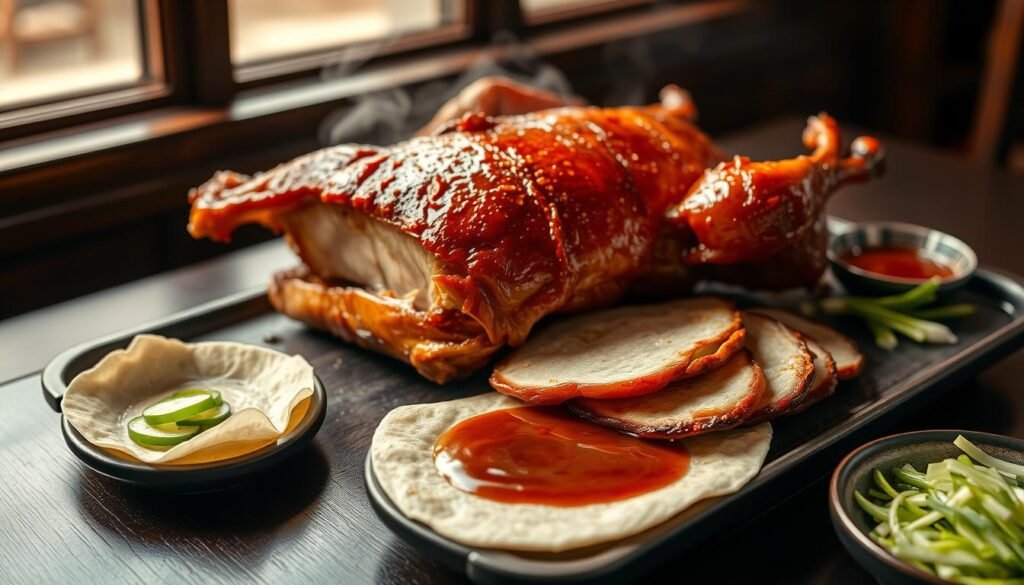
The Forbidden City: Exploring China’s Imperial Past
The Forbidden City is a key part of Beijing’s history. It’s a must-visit spot in Beijing that draws millions yearly.
This palace was home to 24 emperors. It has 980 buildings and over 8,700 rooms. It’s a marvel of architecture and a treasure of culture, filled with historical artifacts and artworks.
Essential Halls and Courtyards Within the Palace Complex
The Forbidden City has many important sites. The Hall of Supreme Harmony was used for big ceremonies. The Palace of Heavenly Purity was the emperor’s home.
- The Palace of Heavenly Purity served as the emperor’s residence and a symbol of his power.
- The Imperial Garden, with its intricate landscaping and serene atmosphere, provided a tranquil retreat for the imperial family.
Practical Visitor Tips and Best Photography Spots
Arrive early to beat the crowds and heat. Wear comfy shoes for all the walking. Don’t miss the Gate of Supreme Harmony and Jinshui Bridge for great views and photos.
Recommended Guided Tour Options in English
Join a guided tour in English for a deeper look. Many tours are available, from general to specialized ones on architecture or cultural relics.
Visiting the Forbidden City lets you appreciate China’s rich culture. It’s a UNESCO World Heritage site with great historical value.
Beijing’s Breakfast Culture: From Jianbing to Doujiang
Beijing’s breakfast culture shows the city’s rich history and diverse food scene. The morning streets are filled with the smells of traditional dishes. This draws both locals and visitors to try the authentic flavors of Beijing.
Morning Food Rituals and Must-Try Breakfast Items
Beijingers really value their breakfast. They love Jianbing (savory crêpes) and Doujiang (soy milk). Jianbing is a must-try for its crispy texture and tasty fillings. Doujiang, with youtiao (fried dough sticks), is a comforting drink.
“Breakfast is the most important meal of the day,” as the saying goes. In Beijing, it’s a mix of tradition and local tastes. A local vendor said, “Our breakfast dishes have been passed down through generations, each with its own story and significance.”
Where Locals Go for Their Morning Meals
Locals often go to street food stalls and traditional eateries for breakfast. These busy stalls offer many breakfast choices, like baozi (steamed buns) and ji dan bing (egg pancakes).
Navigating Street Food Stalls with Limited Mandarin
For visitors with limited Mandarin, finding street food stalls can be tough. But, many vendors are happy to help. Some stalls even have pictures of their dishes.
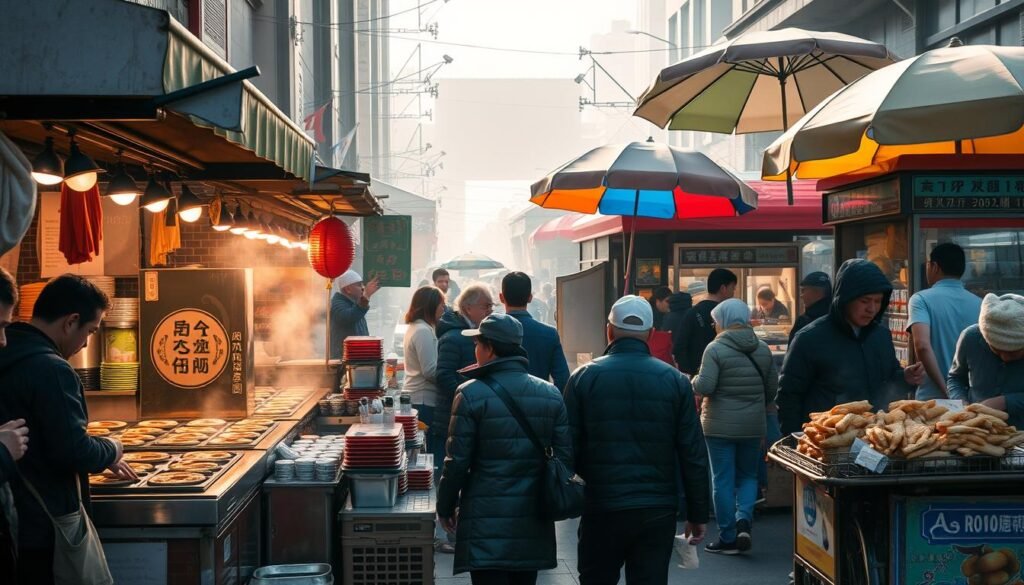
Learning basic phrases like “我要一个jianbing” (I want a Jianbing) can also help your breakfast experience.
The Great Wall Experience: Choosing Your Perfect Section
The Great Wall of China offers a wide range of experiences. It’s a top attraction in Beijing, perfect for anyone visiting. Each section provides a unique adventure.
The Wall is famous for its history and stunning architecture. You can pick from several sections, each with its own charm.
Comparing Mutianyu, Badaling, and Jinshanling Sections
Mutianyu, Badaling, and Jinshanling are the most visited parts of the Great Wall. Here’s a quick look at what each offers:
| Section | Features | Crowd Level |
|---|---|---|
| Mutianyu | Steep climbs, scenic views | Moderate |
| Badaling | Well-maintained, tourist facilities | High |
| Jinshanling | Remote, less restored | Low |
Transportation Options from Central Beijing
Getting to the Great Wall from Beijing is easy. You can take a private car or taxi, use a public bus, or join an organized tour. The trip takes 1-2 hours, depending on traffic and the Wall section you choose.
Seasonal Considerations and Crowd Avoidance Strategies
To avoid the crowds, visit during the shoulder season (April-May or September-October). The weather is nice, and there are fewer tourists than in summer.
Beijing Famous Food and Famous Places That Define the Capital
Beijing has a rich history of over three millennia. Its famous food and landmarks show its cultural and culinary importance. Visitors can enjoy iconic dishes and see historical sites that shaped Beijing.
Eight Signature Dishes That Represent Beijing’s Culinary Heritage
Beijing’s food is known worldwide for its unique flavors. Some dishes you must try include:
- Peking Duck: A dish fit for emperors, known for its crispy skin and tender meat.
- Jiaozi: Boiled or pan-fried dumplings that are a staple in Beijing cuisine.
- Zha Jiang Mian: A savory noodle dish topped with fermented soybean sauce.
- Zhajiangmian: A popular noodle dish with a rich, savory sauce.
- Douzhi: A fermented soybean drink that’s a unique Beijing specialty.
- Beijing-style Hot Pot: A communal dining experience featuring a simmering pot of broth.
- Lou Mei: Savory cold dishes that are perfect for hot summer days.
- Guantang Baozi: Soup-filled buns that are a comforting breakfast option.
The Five Landmarks Every First-Time Visitor Must See
Beijing has many historical landmarks to explore. These include:
- The Great Wall of China: An ancient series of fortifications that symbolize China’s rich history.
- The Forbidden City: The imperial palace of the Ming and Qing dynasties.
- The Temple of Heaven: A complex of religious buildings where emperors once prayed for good harvests.
- The Summer Palace: A sprawling garden complex with lakes, temples, and pavilions.
- Tiananmen Square: A vast public square surrounded by significant historical and governmental buildings.
Creating the Perfect 3-Day Itinerary
For the best Beijing experience, plan a 3-day trip. Start with a traditional Beijing breakfast. Then, visit the Forbidden City and Tiananmen Square.
On the second day, see the Great Wall and enjoy Peking Duck. On the third day, visit the Temple of Heaven and stroll through the Summer Palace. This plan balances Beijing’s food and history.
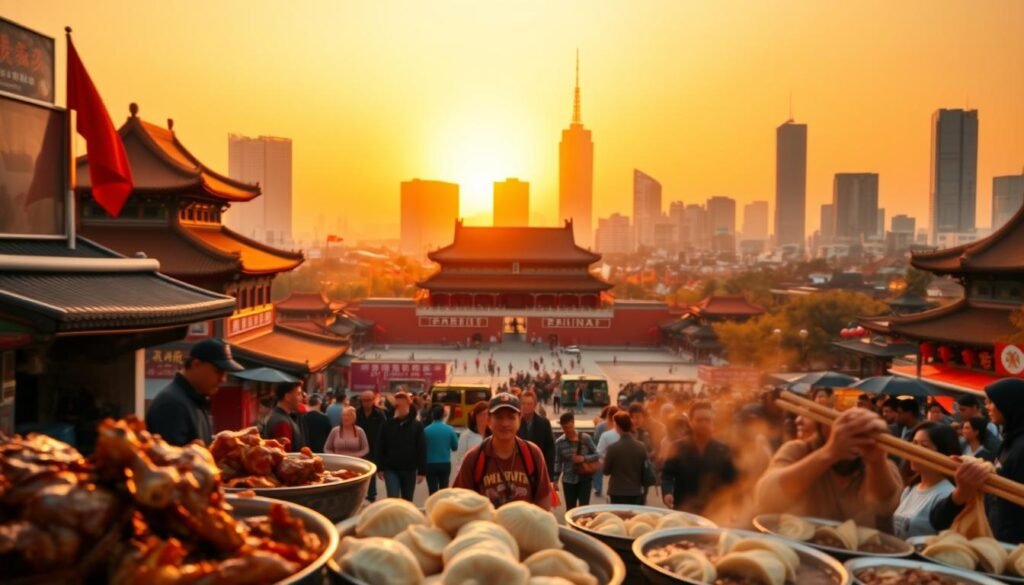
Hutong Exploration: Food and Culture in Beijing’s Ancient Alleyways
Exploring Beijing’s Hutongs feels like a journey back in time. Every corner reveals a new culinary treasure. These ancient paths are filled with traditional culture and food, giving visitors a peek into Beijing’s rich past.
Traditional Snacks and Dishes Unique to Hutong Areas
The Hutongs are famous for their traditional snacks and dishes. These foods are a big part of Beijing’s culinary history. You can try fried noodles, mutton skewers, and traditional pastries. These dishes are tasty and give a look into the lives of Beijing’s people.
Nanluoguxiang and Dashilar: Contrasting Hutong Experiences
Nanluoguxiang and Dashilar are two famous Hutongs in Beijing. They offer different experiences for visitors. Nanluoguxiang is trendy with boutiques and cafes. Dashilar is more traditional, with old buildings and local food spots.
Recommended Food Tours with English-Speaking Guides
For the best Hutong food experience, join a food tour with an English guide. These tours take you to local spots and snack shops. You’ll learn about the history and culture of each dish. It’s a great way to see Beijing’s culinary side.
The Summer Palace: Imperial Lakeside Retreat
The Summer Palace is a stunning imperial retreat in Beijing. It’s a popular tourist destination known for its beautiful landscapes and rich history. It holds great cultural significance.
The palace features attractions like Kunming Lake and Longevity Hill. Kunming Lake offers serene boat rides and stunning views. Longevity Hill has temples, gardens, and paths for walking.
Kunming Lake, Longevity Hill, and Garden Highlights
The gardens in the Summer Palace showcase classical Chinese landscaping. Visitors can see temples, pavilions, and gardens. Each has its own architecture and history. The Seventeen-Arch Bridge and the Marble Boat are iconic landmarks.
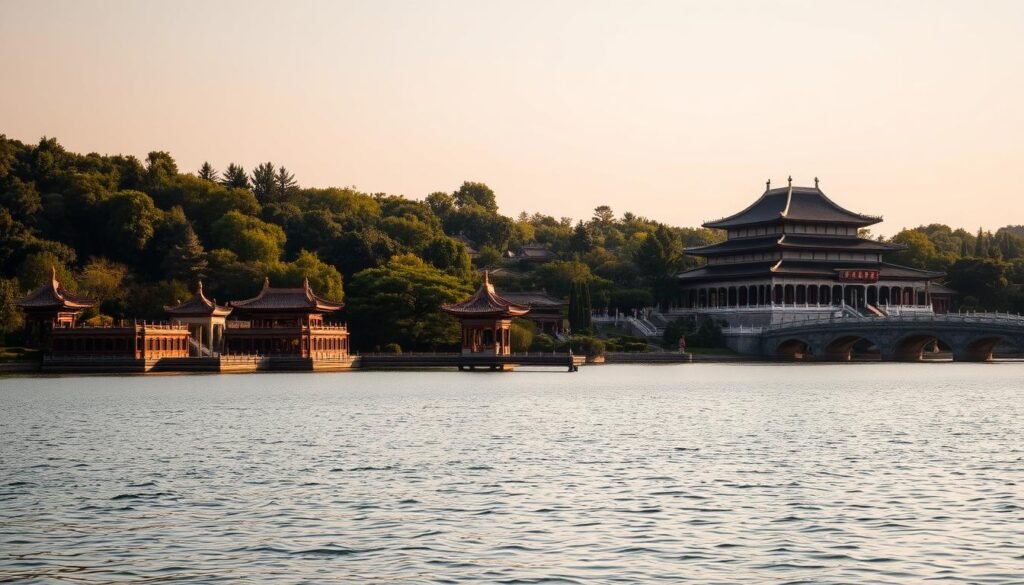
Seasonal Beauty and Ideal Visiting Times
The Summer Palace is beautiful all year. Spring brings flowers, summer has greenery, autumn has foliage, and winter is snowy. Each season offers a unique experience.
Boat Rides and Other Interactive Experiences
Visitors can enjoy many activities at the Summer Palace. Boat rides on Kunming Lake are a favorite. You can also hike Longevity Hill and explore gardens and temples.
Beijing’s Night Food Scene: Markets, Streets, and Hidden Gems
When the sun goes down, Beijing’s food scene lights up. The city’s night markets and food streets are a must-see for food lovers.
Wangfujing and Donghuamen: Navigating Famous Food Streets
Wangfujing and Donghuamen are top spots for food in Beijing. Wangfujing has a mix of local and international dishes. Donghuamen is famous for iconic dishes in Beijing, like skewers and seafood.
Try local treats like mutton skewers and boiled dumplings. The streets are full of life, making for a fun dining experience.
Ghost Street (Guijie): Beijing’s Late-Night Food Paradise
Ghost Street, or Guijie, is Beijing’s go-to for late-night food. It’s filled with restaurants and stalls offering everything from spicy crayfish to Peking duck.
Adventurous Eating: From Scorpions to Stinky Tofu
Ghost Street is perfect for those who dare to try new foods. As a local food blogger said,
“The key to enjoying street food is to be open-minded and willing to try new things.”
Some adventurous foods to try include:
- Scorpion skewers
- Stinky tofu
- Boiled snake and frog legs
Beijing’s night food scene shows off the city’s rich food culture and diversity. Whether you’re trying famous dishes or new flavors, it’s an experience you won’t forget.
Temple of Heaven and Beijing’s Sacred Architecture
The Temple of Heaven in Beijing is a stunning architectural wonder. It has been a key spiritual site for centuries. This place shows the city’s deep cultural and historical roots.
Understanding the Religious and Astronomical Significance
The Temple of Heaven was where emperors held rituals for good harvests and wealth. Its design reflects ancient Chinese astronomy, linking heaven and earth. It’s a special historic landmark in Beijing, blending religious and astronomical themes.
The Surrounding Park: Where Locals Exercise and Socialize
The park around the Temple of Heaven is a lively spot for locals. They come here to exercise and hang out. Visitors can see traditional activities, mainly in the mornings.
Morning Visits: Witnessing Tai Chi and Traditional Activities
Morning visits to the Temple of Heaven are special. The park buzzes with locals doing Tai Chi, dancing, and playing traditional music. It’s a great time to see Beijing’s local culture and daily life.
| Activity | Time | Location |
|---|---|---|
| Tai Chi | 6:00 AM – 7:00 AM | North Park Area |
| Traditional Dancing | 7:00 AM – 8:00 AM | Central Plaza |
| Chinese Music | 8:00 AM – 9:00 AM | Near the Temple |
Modern Beijing: From 798 Art District to Contemporary Cuisine
The city’s art scene and new foods are changing Beijing. It’s becoming a cultural center, mixing old traditions with new ideas.
Beijing’s Art Scene and Creative Spaces
Beijing’s art scene is booming, with the 798 Art District at its heart. This old industrial area is now a lively cultural spot. It’s filled with galleries, studios, and art spaces.
Key attractions in the 798 Art District include:
- Contemporary art galleries showcasing local and international artists
- Unique boutiques and design studios
- Cafes and restaurants offering a modern dining experience
Innovative Restaurants Blending Tradition with Global Influences
Beijing’s food scene is also getting a makeover. Restaurants are mixing traditional Chinese dishes with international flavors.
Some notable examples include:
| Restaurant | Cuisine | Notable Feature |
|---|---|---|
| Restaurant 1 | Modern Chinese | Innovative use of traditional ingredients |
| Restaurant 2 | Global Fusion | Unique flavor combinations |
| Restaurant 3 | Contemporary Chinese | Elegant presentation and atmosphere |
Beijing’s Emerging Craft Beer and Coffee Culture
Beijing is also growing its craft beer and coffee scenes. Local breweries and coffee shops are becoming favorites among both locals and tourists.
“The craft beer scene in Beijing is exciting and rapidly evolving, with many local breweries offering unique flavors and experiences.” – Local Beer Enthusiast
Practical Tips for Your Beijing Food and Landmark Adventure
Beijing is a city that mixes old traditions with new modern ways. It has lots of tasty foods and famous sights to see. To enjoy your trip, planning is key.
Exploring Beijing’s food scene? Try local markets and street food like Jianbing and Doujiang. They offer real Beijing tastes. For Peking Duck, go to famous restaurants known for this dish.
Don’t miss Beijing’s famous places like the Forbidden City and the Great Wall. They show the city’s deep history and culture. Check the opening times and ticket availability for these landmarks.
Beijing has history, culture, and food for every traveler. With some planning, your visit will be unforgettable. Enjoy this amazing city!